

To the land where the mangrove trees grow and the waters glow!
The trees of the tropical isles that grow thickly together standing in salt water or sunk in sand, mud, marl or muck are among the most adaptive forests to the harshest conditions on earth; yet thrive they do.
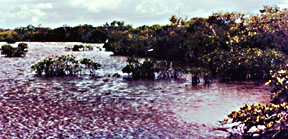
Mangrove trees ring the shallow tidelands along the saltwater shores of Florida Bay.
The term mangue is of either Spanish, Portuguese or Malay origin appearing in the 1500s after both countries had contact with tropical areas of the East Indies. The Malay term mangi-mangi is one suggestion for the Portuguese mangue, the same word is found in Spanish in 1519.
Grove is an English word for a thick stand of trees.
Mangroves are actually salt tolerant forests of tropical shores whose species composition along the Coral Coast include Luguncularia racemosa, Avicennia germinans, and Rhizophora mangle.
See ITIS, the Integrated Taxonomic Information System for their range.
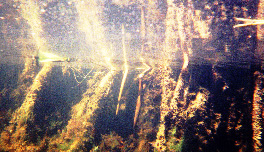
Mangrove roots are places for crabs, mollusks, algae, sea squirts or tunicates, sponges, salps and oysters to thrive in the sublittoral zone.
The Florida stone crab, Menippe mercenaria, an economically valuable species, live along the shores of the coral coast and consume whelks a form of marine snail. (Carson, p. 151) The young live in shoreline rubble (found on the sand and coral coasts), old oyster shells, and on pilings. Adults move out to shallow water and normally live in burrows." According to Gilbert Voss, a deceased marine taxonomist, "In the stone crab fishery only the claws are harvested, the crabs soon grow new ones."
(Gilbert L. Voss. Seashore Life of Florida and the Caribbean, p.106.)
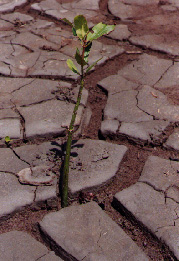
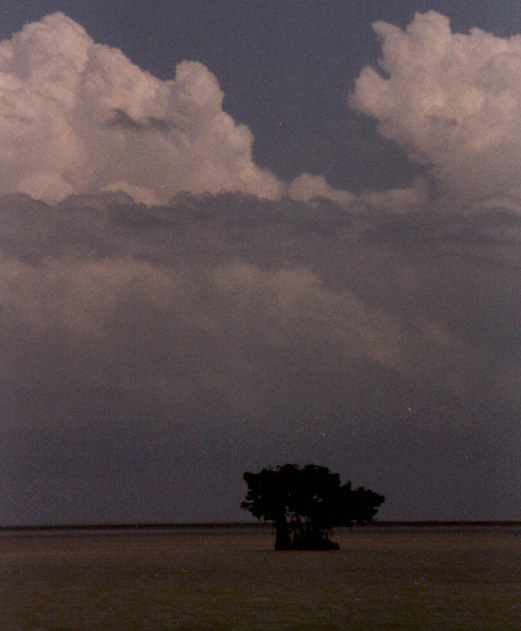
Rhizophora mangle taking root in a Guyana mud flat may, in time, grow into a tree island.
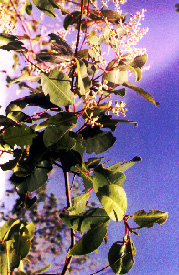
Luguncularia racemosa is the so called "White" mangrove.
In the Black mangrove zone of the intertidal habitats, Avicennia Germinans, is the dominant tree species. Indicators of the presence of the "black" mangrove tree, are these projecting roots exchange gases for the trees that are otherwise rooted in anoxic mud, that is mud with little or no oxygen.
pneumatophores are the aerial shoots of the black mangrove's root system that protrude above the mud.
Sea Grass beds are tied ecologically to mangroves & coral reefs.
The neighboring habitats, mangroves and coral reefs, rely on seagrass beds for their health. Seagrass beds provide special services for these other areas.
"Seagrass is an indicator of good water quality because it declines rapidly in the presence of pollutants and excess nutrients. As rivers empty into the sea, they carry fresh water, silt and chemicals—all of which can kill coral.
Seagrass beds improve water quality by absorbing low levels of excess nutrients and mixing the fresh water with the salt water. The roots and blades of seagrass trap, filter, and recycle nutrients, such as phosphorus and nitrogen, and transform them into something that can be eaten by other organisms."
Sea Grass beds examined at the Shedd Aquarium.
Beach Replenishment in Punta Cana, Dominican Republic: Effects on Seagrass,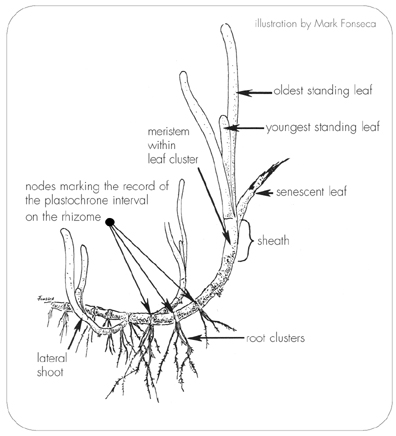
Benthic Invertebrates, Sediment, and Water Quality
Rebecca Gentry
Seagrass is a keystone species in this near shore habitat; it greatly influences both the biological and physical environment. Health and productivity of the near shore zone is essential in maintaining clear water, sandy beaches, and an abundance of reef fish. More research needs to be done in order to learn the most effective ways of balancing continued development with protection of these vital resources."
"Primary producers are quantitatively important in shallow coastal ecosystems, and although these areas represent less than 2% of the oceanic surface they produce about 20% of the global marine primary production."
Estuarine Nutrient Cycling: The Influence of Primary Producers. By Søren Laurentius
Nielsen, Gary Thomas Banta, Morten Foldager Pedersen, Springer, Published 2004.
See what lives in these underwater grassland beds and what the grasses look like.

From the West Bengal mangroves roamed by fierce tigers of the Sunderbans, mangrove forests provide a habitat, that is the tigers home, to this huge carnivore. The productive quality of these waters begins with the sunlight, water and trees and extends up from bacteria, diatoms and algae through to the shrimp rich waters of the surrounding seas. The Sunderbans is a National Park in India's West Bengal at the mouth of the Brahmaputra and Ganges deltas with over 2585 square kilometers protected for tigers. some 250 reported tigers.
Mangroves are true maritime forests. Similarly to coastal grasslands, they have not been well understood by modern industrial engineering. In East India after the great tsunami of 2004, the villages situated behind mangrove forests were afforded greater protection than those people trapped along the open beach. In an era of rising sea levels the vegetation that holds the sand and mud steady along the shore is of ever greater importance to the defense of the shore and the protection of human life.
Mangroves are tropical and are thus associated with coral reefs and indeed health mangrove lined shores help to strain out debris that could raise the turbidity of the water causing murkiness to cut down on the light received by corals, sea grasses and algae under the sea.

As a result of the increase of the level of the tide, - consequence of global warming, - the reserve of Sunderbands, in India, the considered like but great world-wide colony of tigers, is in danger. The colony of tigers that inhabits Sunderbands has descended vertiginously, happening of about 500 members, to about only 250.
The ecosystem of Sunderbands (Sunderbans) is characterized to have one important number of small islands, whose water channels are covered by manglares. Traditionally the tigers have swum between these, to move in search of foods. Nevertheless the increase of the water level, is producing pernicious effects in the territory, preventing the natural behavior of the felines.
The reserve of Sunderbands is one of the greater ecosystems of manglares of all Asia and has been declared reserve of the humanity by the UN. Nevertheless the increase of the level of the tide has covered already two islands. The authorities of Sunderbands fear that global warming still aggravates plus the problem, with which the survival of the tigers is in danger.
See MSNBC, 3-4-2007 discussion.
![]()
![]()